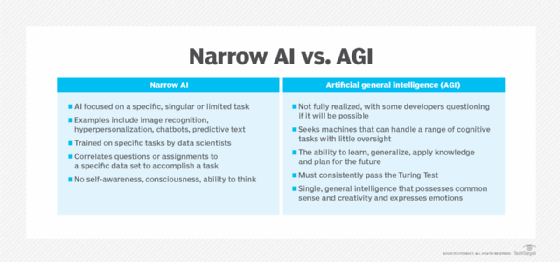
Getty Images/iStockphoto
General AI vs. narrow AI comes down to adaptability
AI today has limited and specific applications, but the continual growth of the technology may just lead to the replication of human intelligence through general AI.
Many AI applications focus on solving specific tasks, while the machine capable of human-like intelligence has yet to come to fruition. These divergent concepts of AI fall into two general buckets: artificial general intelligence and narrow AI.
Narrow AI applications focus on one problem, while artificial general intelligence focuses on building intelligent systems that can handle any task or problem in any domain. The promise of AGI remains unfulfilled, but the drive toward the technology pushes the abilities of AI.
What is general AI?
The ultimate vision of AI are systems that can handle a wide range of cognitive tasks. The idea of a single, general intelligence that can act and think like a human is commonly referred to as artificial general intelligence. AGI is focused on creating intelligent machines that can successfully perform any intellectual task a human can, with the ability to generalize knowledge between various domains and to take knowledge from one area and apply it somewhere else.
AGI seeks machines that can make future plans based on previous knowledge and experiences.
For AI to be generally intelligent, it must be able to adapt as changes occur in the environment. Humans can adapt to new surroundings by pulling from past experiences, and AI must be able to do the same. Additionally, there are ancillary aspects that the AI must possess to be generally intelligent. This includes the ability to reason, represent common sense, express creativity, express emotions and have an emotional IQ, and possess the ability to plan and predict.
The Turing Test, created to assess machine intelligence, puts a human, a machine and an interrogator in a conversational setting. If the interrogator can't distinguish between the human and the machine, then it passes the Turing Test. Reaching AGI successfully requires the machine to consistently pass the Turing Test -- something only a few very advanced chatbots have been able to accomplish.

What is narrow AI?
Narrow AI can be defined as anything that isn't AGI; basically, any example of AI in use today is narrow AI. These systems can handle a singular or limited task, but this focused approach still produces powerful capabilities. Examples include image recognition, hyperpersonalization systems, goal-driven systems, AI powered chatbots, speech recognition and natural language processing, predictive maintenance systems and even self-driving vehicles.
As we continue to push the boundaries of what's possible with AI, our definition of narrow AI changes as well. A few decades ago, optical character recognition was considered broad, cutting-edge AI. Now that this technology has become a reality, people no longer consider it AI. People's perception of AI, and narrow AI specifically, will continue to evolve as technology continues to advance.
The term weak has been used in place of narrow, but this is misleading because from the perspective of AI researchers, any AI application trying to address the sort of general intelligence that humans have is strong. This pejorative term is not at all a proper perspective on AI; in fact, most narrow AI applications are incredibly powerful, focused and successful.
AI applications are tools to solve the problems organizations have daily. Though AI technologies are being applied to specific problem areas rather than the goal of general intelligence, they remain significantly powerful. On the contrary, some machine learning applications are addressing the core of many business problems -- from insurance to medical imaging, machine translation, conversational agents and beyond.
Are we close to AGI?
There are many luminaries in the field with very different views on where developers are in the process of bringing about AGI. Some are of the opinion that we're just a few years away from achieving this general intelligence. Others believe we are hundreds of years away, and still others think we'll never achieve AGI.
Rodney Brooks, an MIT professor and founder of the defunct Rethink Robotics, thinks we are hundreds of years away from achieving AGI. On the other end of the spectrum is Ben Goertzel, CEO and founder of the SingularityNET Foundation, who believes we are at a turning point in the history of AI. He thinks that over the next few years the balance of activity in AI research will shift from highly-specialized narrow AI toward AGI.
Despite the efforts of many researchers and companies, there are still many obstacles to achieving the goals of AGI. Computing infrastructure, funding and building AGI-appropriate hardware are some of the barriers that currently exist.
However, researchers continue to push forward. As a result, we expect interest, funding and resources to continue to be poured into AI efforts. While achieving AGI remains uncertain, the journey toward AGI continues to push the boundaries of what is possible.






